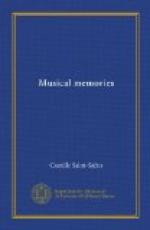If this is the case, what shall be said of marking the fingering on all the notes—which often makes good playing impossible. Liszt taught hundreds of pupils according to the best principles, yet such erroneous principles have prevailed!
Disciples of the ivory keys are numerous in our day. Everybody wants to have a piano, and everybody plays it or thinks he does, which is not always the same thing, and few really understand what the term “to play the piano,” so currently used, means.
The harpsichord reigned supreme before the appearance of the piano—an instrument which is beloved by some and execrated by others. To his utter amazement Reyer was considered an enemy of the pianoforte. The harpsichord has been revived of late so that it is needless to describe it. It lacks strength, and that was the reason it was dethroned in a period when strength was everything. On the other hand, it has distinction and elegance. As the player can not modify the intensity of the sound by a single pressure of the finger—in which it resembles the organ—like the organ, with its multiple keyboards and registers, the harpsichord has a wide variety of effects and affords the opportunity for several octaves to sound simultaneously. As a result, while music written for the harpsichord gains in strength and expression on the modern instrument, it often assumes a deceptive monotony for which the author is not responsible.
The players of the harpsichord were ignorant of muscular effects; there was nothing of the unchained lion about them. The delicate hands of a marquise lost none of their gracefulness as they skimmed over the keyboards, and the red or black keys emphasized their whiteness.
The introduction of the hammer in the place of the tiny nib permitted the modification of the quality of sound by differences in the pressure of the fingers, and also the production at will of such nuances as forte and piano without recourse to the different registers. This is the reason why the new instrument was first called the pianoforte. The word was long and cumbersome and was cut in half. When it became necessary to assault the note, they used the phrase “to hit the forte.” The papers which gave accounts of young Mozart’s concerts praised him for his ability to “hit.”
Nevertheless one did not hit hard. These keyboards with their limited keys responded so easily that a child’s fingers were sufficient. I first played on one of these instruments at the age of three. It was made by Zimmerman, whose son was Gounod’s father-in-law.
Later, the weight of the keys was increased to get a greater volume of sound. Then, when long-haired virtuosi, playing by main strength, produced peals of thunder, they really “toucha du piano.”
* * * * *
To return to Orphee and end as we began, I have to make a painful confession. If the works of Gluck in general and Orphee in particular have had a happy influence on our musical taste, a passage from this last work has been a noxious influence,—the famous chorus of the demons “Quel est l’audacieux—qui dans ces sombres lieux—ose porter ses pas?”




